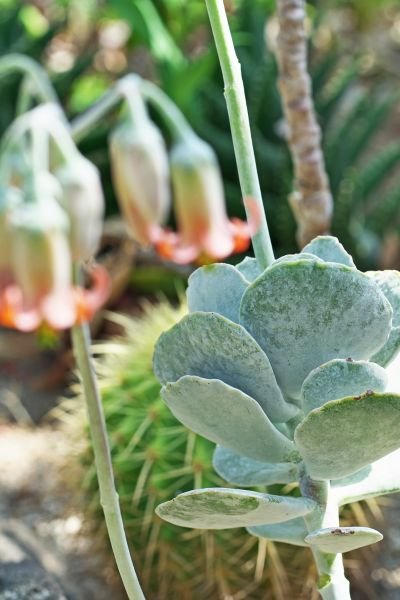Cotyledon Pendens, also known as Cliff Cotyledon, is a striking trailing succulent native to South Africa. This unique succulent, characterized by its round, fleshy leaves and vibrant orange bell-shaped flowers, belongs to the Crassulaceae family. With its stunning appearance and low-maintenance nature, Cotyledon Pendens is an excellent choice for both home and office decoration, making it the perfect indoor plant for those without a green thumb. In this comprehensive guide, we will explore the essential aspects of caring for Cotyledon Pendens to ensure it thrives and graces your space with its beauty.
Read about Dischidia Hirsuta Red Leaf here

Sunlight: The Key to a Happy Cotyledon Pendens
Like most Cotyledon succulents, Cotyledon Pendens thrives with minimal care but thrives on abundant sunlight. Providing your succulent with full to partial sunlight for approximately 6-8 hours each day is ideal. Ample sunlight enhances its vibrant colors, ranging from red to pink.
However, it’s crucial to strike a balance. While Cotyledon Pendens loves sunlight, direct exposure throughout the day can lead to sunburn. To prevent this, place your succulent in a sunny spot without direct sunlight. If you choose to grow Cotyledon Pendens outdoors in spring and fall, ensure the sun in your area is mild and not too intense. For indoor cultivation, a south-facing windowsill is perfect. Remember to rotate the plant and provide shade during the summer. In winter, consider using grow lights to prevent leaf drop due to insufficient light.
Watering: Finding the Right Balance
Cotyledon succulents, including Cotyledon Pendens, have thick leaves that store water, allowing them to endure periods of neglect. However, overwatering or frequent watering can harm your succulent and even lead to its demise. Here are some watering tips to keep your Cotyledon Pendens healthy:
- Check the soil’s dryness by using your fingers or a moisture meter.
- Wrinkled leaves at the bottom indicate underwatering.
- Water thoroughly until excess water drains from the pot’s holes.
- Reduce watering frequency in winter and summer.
- Avoid wetting the leaves while watering.
- After watering, place your succulent in a well-ventilated area to prevent waterlogged soil.
For further guidance on identifying signs of overwatering or underwatering in succulents, please refer to this resource.
Soil: The Foundation of Healthy Growth
Cotyledon Pendens thrives in well-draining and porous succulent potting soil, which helps remove excess water and prevents overwatering. A cactus soil mix is generally suitable for most succulents. To improve soil drainage, you can add materials like sand, grit, perlite, and pumice. Ensuring your pot has a drainage hole is crucial, especially for trailing succulents like Cliff Cotyledon. Consider using a hanging planter pot to fully showcase its beauty.
Fertilizing: Providing Nutrients Wisely
In general, Cotyledon succulents obtain sufficient nutrients from the soil. However, if you wish to promote faster growth, consider using succulent-specific fertilizer. Opt for fertilizers with low nitrogen content and follow the recommended dilution ratios for succulent fertilizers. It’s best to fertilize your Cotyledon Pendens in the spring when new growth is most active. Applying fertilizer once a month should suffice.
Temperature and Humidity: Creating the Ideal Environment
Cotyledon Pendens thrives in temperatures ranging from 30°F to 50°F. If your area falls within USDA hardiness zones 10-11, it’s preferable to grow this succulent outdoors. In regions with lower hardiness zones, it’s advisable to keep your Cotyledon Pendens indoors during winter to protect it from frost. For detailed guidance on caring for succulents in winter, please refer to this resource.
Maintaining the right humidity levels is also crucial. Cotyledon Pendens prefers humidity levels between 40% and 60%. In dry climates, you may need to use a humidifier to prevent the air from becoming too dry, which can hinder growth. High humidity can lead to fungal infections and root rot, so monitoring humidity is essential for the well-being of your succulent. For further insights into how humidity affects succulents, please consult this resource.
Propagation: Creating New Cotyledon Pendens
If you’re interested in propagating your Cotyledon Pendens, there are several methods available, including seeds, cuttings, leaves, and offsets. To propagate successfully, follow these steps:
- Obtain a portion of leaves, cuttings, or offsets from a healthy Cotyledon Pendens.
- Allow the cut ends to dry and callus.
- Plant them in well-draining soil.
- Water sparingly until roots develop.
For a more in-depth guide on propagating succulents from stem cuttings, please refer to this resource.
Pests and Toxicity: Protecting Your Plant and Pets
Keep a vigilant eye for potential pests like mealy bugs or spider mites, which can harm your Cotyledon Pendens. At the first sign of infestation, promptly address the issue by washing the succulent with water, soap, or neem oil.
Additionally, it’s essential to keep Cotyledon Pendens away from pets, as the plant is toxic to most animals, including dogs, cats, and rabbits. Ingesting the leaves can lead to illness due to the presence of neurotoxins. For a list of pet-safe succulents, please refer to this resource.
The Joy of Blooming
The patience you invest in caring for Cotyledon Pendens will be rewarded with a profusion of beautiful flowers. As you nurture this remarkable succulent, anticipate the day when it bursts into full bloom, filling your space with its unique charm and fragrance.
In conclusion, caring for Cotyledon Pendens involves providing the right balance of sunlight, water, soil, and nutrients, as well as maintaining the ideal temperature and humidity levels. By following these guidelines, you can ensure that your Cotyledon Pendens thrives and graces your space with its beauty for years to come.
Pingback: The Ultimate Guide to Growing and Caring for String of Frogs
Pingback: How to Grow and Care for Broom Plants Gardeners Schoo
Pingback: Discover the 9 Best Mother of Thousands Varieties | Mother of Millions Types